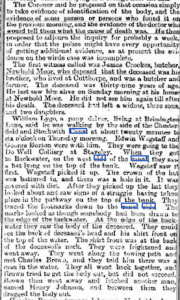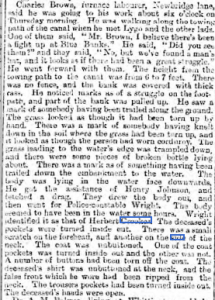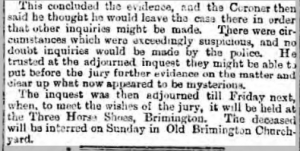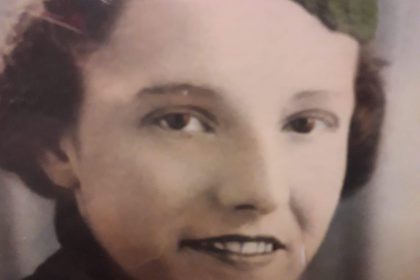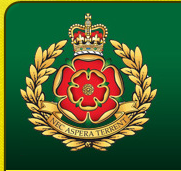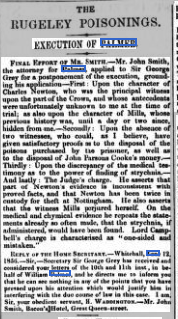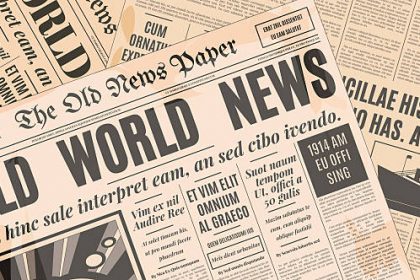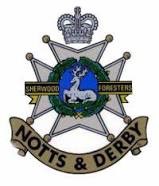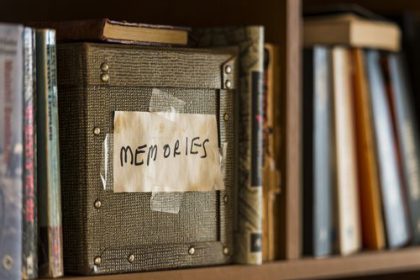THE INQUEST. No further facts have come to light as to the circumstances under which Herbert Crookes butcher, of Cutthorpe and Clowne, came by his death on Wednesday night last. The police are actively investigating the matter, but up to the present have not obtained a clue to the perpetrators of the murder which has caused such a sensation in the neighbourhood of Brimington and Chesterfield.
The deceased man’s widow was not informed of the occurrence till Thursday afternoon, and yesterday she visited Wheeldon Will, where the body is lying, in company with her brother-in-law and several friends. Various theories are afloat as to the circumstances of Crookes ‘death. Whilst some think he was robbed and murdered for the sake of the money some £4O which is known to have had in his possession, others think he was attacked by persons who owed him a grudge.
Some weight is given to the former theory by the fact that when the body was taken from the water it was found that, with one exception, all his pockets had been turned inside out, and that his money was missing. It has been ascertained that during Wednesday the murdered man was in Sheffield, and that he left there for Clowne early in the day. His furniture was removed from his farmstead at Cutthorpe on Wednesday and he had arranged to return to Cutthorpe at night, hence it was he started for home in the evening.
There is no main road from Clowne to Cutthorpe, and the way in many parts is exceedingly lonely, particularly near that part of the canal in which the body was found. It is stated that deceased might have gone across the country between the two places but according to his widow he has latterly been in the habit of walking along the canal side, thinking that he was less likely to be molested taking that route. A month or so ago three men behaved in a suspicious manner towards him when he got to Toughbrook, not far from Wheeldon: Mill, and he in consequence returned to Clowne. Since then he had taken to retaining home along the towing path by the canal. It is believed that more than one person was concerned in his murder. Crookes was a tall, powerfully built man, and with only one assailant could no doubt have held his own, hence the idea that more than one person must have attacked him. The inquest was opened at the New Inn Wheeldon Mill, yesterday afternoon, before Mr. C G Busby, the coroner for the hundreds of Scarsdale. The jury, whom Mr. John Lingard was the foreman, included several gentlemen who acted as jurymen in the Brimington tragedy five years ago. ‘ After the jury bad been sworn they proceeded to view the place where the body was found, and afterwards the body, which was lying in a cottage near the inn.
The Coroner said he proposed on that occasion simply to take evidence of identification of the body, and the evidence of some person or parsons who found it on the previous morning, and the evidence of the doctor who would tell them what the cause of death was. He then proposed to adjourn the inquiry for probably a week, in order that the police might have every opportunity getting additional evidence, as at present the evidence on the whole case was incomplete. The first witness called was James Crookes, butcher, New hold Moor, who deposed that the deceased was his brother, who lived at Cutthorpe, and was a butcher and farmer. The deceased was thirty-nine years of age. He last saw him alive on Sunday morning at his house at Newbold Moor. He did not see him again till after his death. The deceased had left a widow, three sons, and two daughters.
William a pony driver, living at Brimington Lane, said he was walking the side of the Chesterfield and Stockwith Canal at about twenty minutes to six o’clock on Thursday morning. Edwin Wagstaff and George Burton were with him. They were going to the Well Colliery Staveley. When they got to Backwater, on the west side of the canal, they saw a hat lying the top the bank. Wagstaff saw it first. Wagstaff picked it up. The crown of the hat was battered in, and there was a hole in it. It was covered with dirt. After they picked up the hat they looked about and saw signs of a struggle having taken place in the pathway on the top the bank.
They traced two footmarks down to the canal side. The marks looked as though somebody had been drawn to the edge of the backwater. At the edge of the back water they saw the body of the deceased. They could see the back of the deceased’s head and his shirt front on top of the water. The shirt front was at the back of the deceased’s neck. They were frightened and went away. They went along the towing path and met Charles Brown, and they told him there was man in the water. They all went back together, and Brown tried get the body out, but did not succeed. Brown then went away and fetched another man, named Henry Johnson, and between them they dragged the body out.
Charles Brown, furnace labourer, Newbridge lanes said he was going to his work about six o’clock Thursday morning He was walking along the towing path of the canal when met Lygo and the other lads.
One of them said, Mr. Brown, I believe there has been a fight at Blue Banks. “He said, did you see them?” and they said, “No, but we’ve found a man’s hat, and it looks as if there was a great struggle.” He went forward with them. The height from the towing path to the canal was from 6 to 7 feet. There was no fence, and the bank was covered with thick grass. He noticed marks as of a struggle on the footpath and part the bank was pulled up. He saw a mark of somebody having been trailed along the ground. The grass looked though it had been turned up by hand. There was a mark of somebody having knelt down in the soil where the grass had been turned up, and it looked as though the person had worn corduroy. The grass leading to the water’s edge was trampled down, and there were some pieces of broken bottle lying about. There was a mark as of something having been trailed down the embankment to the water. The body was lying in the water face downwards. He got the assistance of Henry Johnson and fetched a drag. They drew the body out and then went for Police constable Wright, the body to have been in the water some hours. Wright identified it as that of Herbert Crookes. The deceased’s pockets were ‘turned inside out. There was a small scratch on the forehead, and another on the side of the neck. The coat was misbuttoned. One of the coat pockets was turned inside out and the other was not. A number of buttons had been torn off the coat. The deceased’s shirt was unbuttoned to the neck, and the false front which wore been ripped from the neck. The trousers pockets had been turned inside out. The deceased’s hands were open.
Dr. A. M. Palmer, living at Whittington, said he first saw the body of the deceased at 11.30 on Thursday morning. He examined the body and found it that of a well-nourished man. The head and shoulders had a very livid appearance, and there was frothing at the m
outh. The fingernails contained sandy soil, similar to the soil on the bank. He found some contusions on the left side about the lower ribs, such as might have been caused by blow from a fist.
They might possibly have been caused by a fall but looked more like blows from fist. There was an abrasion the forehead and contusion. removing the sculp he found some congealed blood under the contusion, which might have been caused by a fall or a blow from a stick. There were no other external marks, He made a post mortem examination. The skin of the hands and feet presented such appearance as to suggest that the body had been in the water seven or eight hours. He found a little digested food in the stomach. The lungs were very much distended. The liver was very much enlarged owing to disease, and the kidneys in a fatty condition.
There was nothing to account for death either the internal or external condition of the body. There was no fracture of the skull. There was slight congestion the membrane of the brain consistent with death by suffocation. In his opinion the cause of death was drowning. The blow the head might have been sufficient to have stunned the deceased for short time. —By the Jury; The liver indicated that the deceased was man of temperate habits. The deceased, when in the water, had evidently made struggle for life.
This concluded the evidence, and the Coroner then said he thought he would leave the case there in order that other inquiries might be made. There were circumstances which were exceedingly suspicious, and I doubt inquiries would be made the police. He trusted at the adjourned inquest they might be able to put before the jury further evidence on the matter and clear up what now appeared to be mysterious. The inquest was then adjourned till Friday next, when, to meet the wishes of the jury, it will be held the Three Horse Shoes, Brimington. The deceased will be interred on Sunday in Old Brimington Churchyard.
BNA © Derby Daily Telegraph – Saturday 27 March 1886

